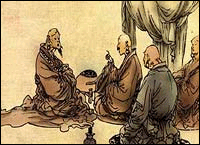God bless the man who first discovered Tea! According to legend, Shen Nung, an early emperor of China, whilst sipping boiling hot water in his garden, caught a leaf from a nearby tea plant in his cup. The taste of the water was altered and he greatly enjoyed the result.
“The effect of tea is cooling, and as a beverage it is most suitable. It is especially fitting for persons of self – restraint and inner worth” - Lu Yu, Ch’a Ching
A Victorian critic, John Ruskin once said, “To see a thing and tell it plain words is the greatest thing a soul can do” and that’s exactly what Lu Yu did.
 Lu Yu?! You might wonder, a peak into the past reveals that he was a highly respected ‘Sage of Tea’. He was best known for his greatest contributions ever – a monumental, first ever treatise on Tea - Ch’a Ching (The Classic of Tea) around the 8th century B.C.E. Yes, that is how far back Tea has been in existence in this world. In this book, Lu Yu talks about the character of Tea, having the combination of Peace, Harmony and Balance. He also gives the 10 aspects of Tea starting from growing to drinking and critical evaluation, while constantly reminding the reader that “its goodness is a decision for the mouth to make”
Lu Yu?! You might wonder, a peak into the past reveals that he was a highly respected ‘Sage of Tea’. He was best known for his greatest contributions ever – a monumental, first ever treatise on Tea - Ch’a Ching (The Classic of Tea) around the 8th century B.C.E. Yes, that is how far back Tea has been in existence in this world. In this book, Lu Yu talks about the character of Tea, having the combination of Peace, Harmony and Balance. He also gives the 10 aspects of Tea starting from growing to drinking and critical evaluation, while constantly reminding the reader that “its goodness is a decision for the mouth to make”At around 1000 B.C.E. the Chinese evolved poetic names for Tea, a tradition that still prevails today, like ‘temple of heaven’ and ‘dragon well’ et all..They also claimed that Tea was an important element in the ‘elixir of immortality.’
Even the Zen Buddhists drank Tea before Bodhidharma (monk who introduced Zen to China from India) in temples as a ritual. Many of the rituals and customs of the Japanese Tea Ceremony can be traced back to this. Later it is said that when the Mongols took over China, Tea was not encouraged. Although, it is said that the custom of social tea drinking continued to prevail.
It was around the 1400 C.E., under the rule of the Ming Dynasty the concept of Tea started becoming global. The Europeans first heard about it as the ‘elixir of the east’ from the Arabs who then controlled the entire sea travel between the East and the West. First sold in apothecaries and a few coffeehouses, the acceptance of tea into British culture was relatively slow.
In 1667 Thomas Garraway, the owner of a coffeehouse known as Garraway's, was one of the first to serve tea. According to Garraway's advertisements tea in Britain had only been used as "regalia in high treatments." He advertised it as a medicinal drink, capable of curing almost anything, and charged £6 to £10 for a pound. Coffee preceded tea by only a few years, but in no time, Tea along with chocolate gained mighty importance. Thanks to a Portuguese Princess, Catherine Braganza, who married Charles II, made tea as the fashionable drink of the court! This high status led to the East India Co.’s greed to become the monopoly in trade and went on a mighty spree of importing Tea from both China and India.
The Assam Tea, although initially considered as an inferior to the Chinese varieties, quickly gained popularity and established itself as a breakfast tea of choice among the Brits even today!
Today, the philosophy of tea is not mere aestheticism in the ordinary acceptance of the term, for it expresses conjointly, with ethics and religion, our whole perception of man and nature.










No comments:
Post a Comment